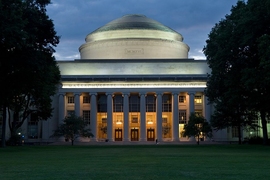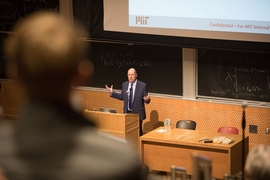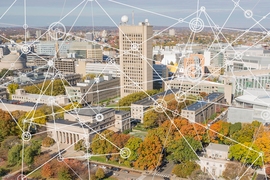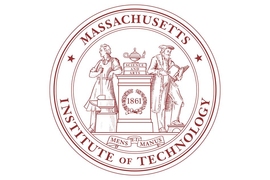MIT has identified a preferred location for the new MIT Stephen A. Schwarzman College of Computing headquarters: the current site of Building 44. The new building, which will require permitting and approvals from the City of Cambridge, will sit in a centralized location that promises to unite the many MIT departments, centers, and labs that integrate computing into their work.
In October, MIT announced a $1 billion commitment to address the global opportunities and challenges presented by the prevalence of computing and the rise of artificial intelligence (AI) — the single largest investment in computing and AI by a U.S. academic institution. At the heart of the initiative is the new college, made possible by a $350 million foundational gift from Mr. Schwarzman, the chairman, CEO and co-founder of Blackstone, a global asset management and financial services firm.
The college aims to: connect advances in computer science and machine learning with advances in MIT’s other academic disciplines; create 50 new faculty positions within the college and jointly with existing academic departments; give MIT’s five schools a shared structure for collaborative education, research, and innovation in computing and artificial intelligence; educate all students to responsibly use and develop computing technologies to address pressing societal and global resource challenges; and focus on public policy and ethical considerations relevant to computing, when applied to human-machine interfaces, autonomous operations, and data analytics.
With those goals in mind, MIT aims to construct a building, large enough to house 50 faculty groups, to replace Building 44, which sits in the center of the Vassar Street block between Main Street and Massachusetts Avenue. Those currently working in Building 44 will be relocated to other buildings on campus.
Scheduled for completion in late 2022, the new building will serve as an interdisciplinary hub for research and innovation in computer science, AI, data science, and related fields that deal with computing advances, including how new computing methods can both address and pose societal challenges. It will stand in close proximity to a cluster of computing- and AI-focused departments, centers, and labs located directly across the street and running up to the intersection of Vassar and Main Streets. All other buildings on campus are about a six-minute walk away.
“You can think of this intersection of Vassar and Main as the ‘entrance to computing,’” says Associate Provost Krystyn Van Vliet, who is responsible for Institute space planning, assignment, and renovation under the direction of the Building Committee, which is chaired by MIT Provost Marty Schmidt and Executive Vice President and Treasurer Israel Ruiz. Van Vliet also oversees MIT’s industrial engagement efforts, including MIT’s Office of Corporate Relations and the Technology Licensing Office.
“The building is intended as a convening space for everyone working to create and shape computing — not just computer scientists, but people who have expertise in the humanities and arts, or science, or architecture and urban planning, or business, or engineering,” Schmidt adds.
Everyone currently located in Building 44 will be moved to their new campus locations by late summer of 2019. Demolition is scheduled to begin in the fall.
While a final design is still months away, a key planned feature for the building will be “convening spaces,” which will include areas set for interdisciplinary seminars and conferences, and potentially an “open office” concept that promotes mixing and mingling. “You can imagine a graduate student from the humanities and a postdoc from EECS working on a project together,” says Dean of the School of Engineering Anantha P. Chandrakasan, the Vannevar Bush Professor of Electrical Engineering and Computer Science. “Such a building can serve as a place for broad community collaboration and research.”
The centralized location is key to the college’s interdisciplinary mission. Building 44 sits directly across the street from Building 38, which houses the Department of Electrical Engineering and Computer Science; the Stata Center, which the Computer Science and Artificial Intelligence Laboratory (CSAIL) calls home; and the Research Laboratory of Electronics in Building 36.
Down the road, on the corner of Main Street, stands the Koch Institute for Integrative Cancer Research and the Broad Institute of MIT and Harvard, both of which incorporate computer science and AI into cancer and medical research. Buildings behind the headquarters on Main Street, in the area known as “Technology Square,” contain many biological engineering, nanotechnology, and biophysics labs.
The new building will also neighbor — and possibly connect to — Building 46, which houses the Department of Brain and Cognitive Sciences, the Picower Institute for Learning and Memory, and the McGovern Institute for Brain Research. “When you think about the work of connecting human intelligence and machine intelligence through computing — which can be physically connected to a building where people are working on understanding human intelligence and cognition — that’s exciting,” Van Vliet says.
The building could thus help “activate” Vassar Street, she adds, because buildings along the street are somewhat visually closed off to the public. The new building, she says, could include windows with displays that visually highlight the research conducted behind the walls, like peering into the labs along the MIT halls.
“Right now, when you walk down Vassar Street, people don’t know what’s happening inside most of these buildings,” she says. “By activation, we mean there’s more community interaction and pedestrian traffic, and more visible displays that draw the public into campus and make them aware of what’s going on at MIT. It will help us show the breadth of MIT’s activities all the way down Vassar Street, for both the growing MIT community and our neighbors.”
A series of launch events for the MIT Schwarzman College of Computing is planned for late February 2019. The search for the college’s dean is ongoing.










